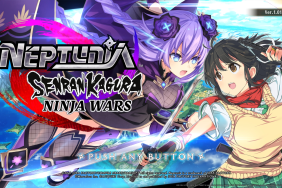“Tits are life, ass is hometown,” said Kenichiro Takaki, producer of Senran Kagura: Shinovi Versus. Therefore, this review will refer to those body parts with those words.
Senran Kagura Shinovi Versus is a third-person action game in which players control anime-style girls with bouncy lives and round hometowns. The fighting formula will seem familiar to Dynasty Warriors and Musou-type game fans, in that it often pits the single player against dozens of enemies at the same time. One will quickly find a groove and figure out almost rhythmic ways of defeating certain enemy types, which the game will counter with sending out more and more foes.
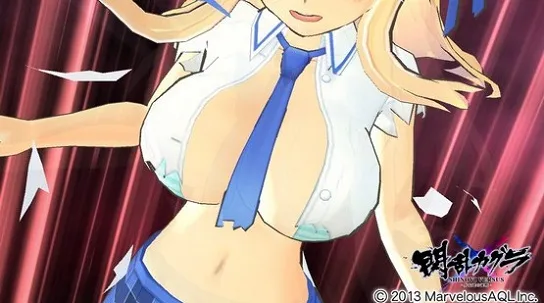
If you’ve seen the images from within this game, the elephant in the room for a review will be the art style and skimpy outfits. Many might wonder if there’s actual nudity in the game, to which the answer is no. Girls losing bits of clothing as they take more damage isn’t a new thing in Japanese games, and Shinovi Versus embraces this design mechanic. While a highly damaged character might be taken down to just her underwear, that’s usually as low as the clothing level gets. Said underwear might be nothing more than a thong and nipple tape, but it’s there. And when it’s not, the game simply tosses up a censor bar that hides much more than the underwear ever did. You’ll see large portions of lives and hometowns, but you’ll never see anyone’s milestones or mayor’s house.
Girls of one school in particular are very likely to lose their panties when defeated, but a big yellow censor bar blocks players from seeing their hometowns. And vaginas. Takaki didn’t use a code word for vagina, so, like, I guess I just have to say vagina when I refer to the ladies’ vaginas. Vagina.
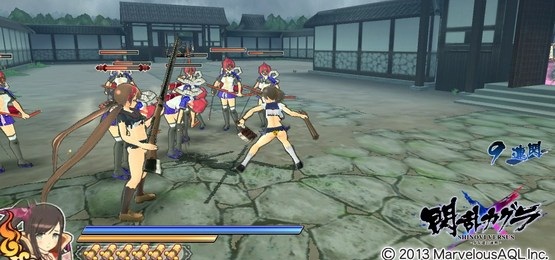
It’s easy to unsuspectingly surrender an awful lot of time to the smooth-flowing, combo-heavy battles of Shinovi Versus. Combat moves along quickly, with the player having to make constant yet careful use of dashes, blocks, counters, combos both on land and in mid-air, and cinematic, over-the-top super moves called Ninpo. For all their damage and flare, these signature attacks, unique to the character, can be executed very easily, making the game highly accessible to those who might not want to spend hours in tutorials.
Shinovi Versus does a good job of providing a variety of enemies with different attributes and attack styles, though combat does often boil down to taking them out in the same way. This can be said of bosses (rival girls from the main cast) as well; the general strategy rarely changes, despite opponents’ greatly varying styles, weapons, specials, and outfits.
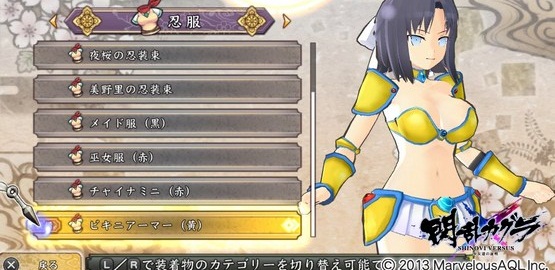
The story is told in two ways, the first and most interesting of which shows the character models standing on opposite ends of the screen and conversing in the way that a lot of Japanese games tend to do. They’ll always be wearing the outfit the player has designated for them; if they just finished a battle, that means they’ll be wearing whatever they were when the fight ended, and in the same condition. The other, somewhat boring storytelling method is simple words on a screen, a small portion of which is voice acted. The game does spice things up and put the text over a picture most times, but occasionally you’ll be looking at text on a black screen. Animated portions of the characters’ interactions are fairly interesting thanks to the over-the-top characters their ever-changing wardrobes. The dialogue is amusing if you can understand it, and adds a welcome layer of entertainment between the fights. If you’re always looking down your nose at cheesy “animu” however, this isn’t going to convert you.

Moving through the game grants more wardrobe bits and other unlockables, most of which become available in the item shop. Those in a hurry can buy some DLC, but as of this writing, it seems that everything can be unlocked normally as well. Outside of battle, players can dress up the girls in any number of ways, choosing outfits for every occasion: her usual, her transformation, and so on, right down to the skivvies.
Online modes add extra fun, with simple deathmatches for up to four combatants, a mode that keeps score based on how much clothing you can rip off your opponents, and a mode that encourages players to run around collecting as many stray pairs of panties as possible. It’s nice to see the formula used in different ways like this. You’ll need an online pass for these online modes, however.
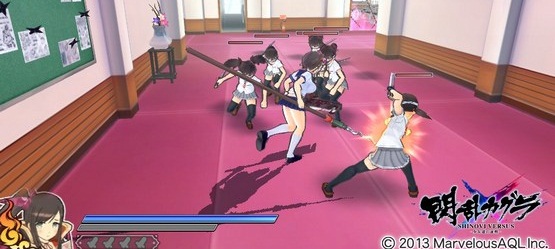
Vita gets a brawler with a little bounce in Senran Kagura: Shinovi Versus. If you roll your eyes at gratuitous zooms into the hometowns and lives of anime girls, then by all means ignore this game, but if not, it proves a decent action game. Those who embrace it will get a welcome change of scenery for the genre. There’s plenty of outfit customization, a very large playable cast, a story that provides an occasional chuckle, and a decent-sized online community.
(Post-review notes for importers. Read the PSLS guide to importing here.)
Those just looking to enjoy the action and look at some half-naked anime girls can easily import Senran Kagura: Shinovi Versus. It won’t take more than two or three fights to get a sense of the controls and flow of combat, and from there, you’ve got an easily playable import on your Vita. Understand, however, that things like patches, DLC, and online play are done through the Japanese PSN, so if your Vita’s usual account isn’t set to the Japanese region, you’ll need to reset your Vita system and get a second memory card in order to switch, unless you’re okay with moving the entirety of you card between your PC and Vita on a constant basis. Consider as well that in order to find a good amount of players online, you might have to play way the hell early or extremely late due to the time zone difference between Japan and your area.
If you want to understand the story, your Japanese level should be decent in all areas, including reading, because most lines of the words-on-black-screen storytelling are not voiced. The best parts of the story are the character interactions, however, so if you’re okay understanding just those, then all you’ll need is some good listening skill; those scenes are almost entirely voice acted. Reading will of course be a bonus, since the scenes come with subtitles. But, of course, I say “reading” meaning a good level of kanji — not just kana — because this is a game targeted at an older audience. No furigana here.

Oh and also:
As another appendix, I’ll mention something that hasn’t happened to me: I’ve read complaints in forums about occasional slowdown with a lot of enemies on screen, but for whatever reason (maybe I’m lucky? I dunno), that’s never happened to me. Make what you will of that, but I didn’t notice slowdown in my hundreds of huge battles in SK:SV. If it’s there, it must be small enough to overlook, at least for me. I did not include this note in the body of my review because it did not apply to my experience and therefore, would be kind of unfair for me to include it.
-
Girls showing off their lives and hometowns.
-
Enemy variety.
-
Wacky characters, perfect for a game like this.
-
Each fighter handles very differently.
-
Online and offline play rewarding in their own ways; neither tacked-on.
-
Story works.
-
You're either into this stuff or you're not.
-
Different enemies still beaten with almost identical strategies.
-
A bit on the easy side.
-
You're either into this stuff or you're not.








